Articles
- Page Path
- HOME > J Korean Acad Community Health Nurs > Volume 24(4); 2013 > Article
-
Original Article
- Effects of Violence Victimization on Mental Health of Children and Adolescents: Analysis of Mediating Effects of Self-concept
- Kyung Mi Sung, Hanju Lee
-
Journal of Korean Academy of Community Health Nursing 2013;24(4):407-418.
DOI: https://doi.org/10.12799/jkachn.2013.24.4.407
Published online: December 31, 2013
1College of Nursing & Institute of Health Sciences, Gyeongsang National University, Jinju, Korea.
2Department of Nursing, Sangmyung University, Cheonan, Korea.
• Received: July 3, 2013 • Accepted: December 15, 2013
© 2013 Korean Academy of Community Health Nursing
This is an Open Access article distributed under the terms of the Creative Commons Attribution Non-Commercial License (http://creativecommons.org/licenses/by-nc/3.0/) which permits unrestricted non-commercial use, distribution, and reproduction in any medium, provided the original work is properly cited.
- 578 Views
- 2 Download
- 4 Crossref
Abstract
-
Purpose
- The purpose of this study is to clarify mediating effects of self-concept on mental health of children and adolescents who fell victim to violence.
-
Methods
- A survey was conducted on 4th, 5th, and 6th graders from 2 elementary schools and 1st, 2nd, and 3rd year students from 3 middle schools (n=2,391). Data were analyzed using descriptive statistics and AMOS.
-
Results
- The mean scores of mental health and self-concept in the subjects were 4.5 and 184.9 respectively. The rate of poor mental health in students who had fallen victim to violence was more than twice as high as that in students who had never experienced it. The self-concept of students who experienced violence had a tendency to decline. Violence experience and self-concept accounted for 47.7%(43.0% for boys and 53.4% for girls) of the changes in mental health. The indirect mediating effects of self-concept were significant.
-
Conclusion
- Based on the findings, the following is suggested. Schools should offer a self-concept improvement program for students with a distorted self-concept caused by falling victim to violence. It could help such adolescents have a positive self image and improve their mental health.
-
This research was supported by Basic Science Research Program through the National Research Foundation of Korea (NRF) funded by the Ministry of Education, Science and Technology (KRF 03-2011-0257).
NOTES
- 1. Baek WH, Son HG. The relationships among the level of domestic violence perceived by middle school students, anxiety, and school adjustments. Korean J Educ Psychol. 2004;18(2):181–193.
- 2. Baumeister RF. Suicide as a escape from self. Psychol Rev. 1991;97(1):90–113.
- 3. Bhang SY, Yoo HK, Kim JH, Kim BS, Lee YS, Ahn DH, et al. Victims of bullying among Korean adolescents: Prevalence and association with psychopathology evaluated using the adolescent mental health and problem behavior screening questionnaire-II standardization study data. J Korean Acad Child Adolesc Psychiatry. 2012;23(1):23–30. Article
- 4. Brunstein Klomek A, Sourander A, Gould M. The association of suicide and bullying in childhood to young adulthood: A review of cross-sectional and longitudinal research findings. Can J Psychiatry. 2010;55(5):282–288. ArticlePubMedPDF
- 5. Choi JW, Kim HJ. Domestic violence affects the mental health of adolescents: Mediating effects of self-concept. Korean J Youth Stud. 2011;18(1):73–103.
- 6. Choi S, Lee YH, Ko SH. The experience of obesity in elementary school students. Qual Res. 2013;14(1):34–44. Article
- 7. Choi YJ. Effects of suicidal ideation in college students who report a history of childhood abuse. J Adolesc Welf. 2012;14(2):307–333.
- 8. Chung HE, Chun JS. Risk factors of adolescents' victimization by school violence. J Adolesc Welf. 2012;14(1):195–212.
- 9. Davidson LM, Demaray MK. Social support as a moderator between victimization and internalizing-externalizing distress from bullying. Sch Psychol Rev. 2007;36(3):383–405. Article
- 10. De Man AF, Gutierrez BI. The relationship between level of self-esteem and suicidal ideation with stability of self-esteem as moderator. Can J Behav Sci. 2002;34(4):235–238. Article
- 11. Foundation for Prevention Youth Violence. 2011 National survey report on school violence in Korea. Seoul: Author; 2011.
- 12. Houbre B, Tarquinio C, Lanfranchi JB. Expression of self-concept and adjustment against repeated aggressions: The case of longitudinal study on school bullying. Eur J Psychol Educ. 2010;25(1):105–123. http://dx.doi.org/10.1007/s10212-009-0005-xArticlePDF
- 13. Hwang ES, Seong YH. The mediating effects of self-conscious affect and the impact of childhood abuse on depression and anxiety. Korean J Play Ther. 2006;9(2):73–89.
- 14. Kaspar V. Mental health of aboriginal children and adolescents in violent school environments: Protective mediators of violence and psychological nervous disorders. Soc Sci Med. 2013;81:70–78. ArticlePubMed
- 15. Kim JY, Jang YE, Min JA. A study on the effect of school violence to adolescent's school adjustment: Moderating effect of parent-child communication. Korean J Youth Stud. 2011;18(7):209–234.
- 16. Kwon JK. The developmental trajectories of victimized experiences and the changing behavior problems-a longitudinal study with applied LLGA & GMM with known class. J Korean Soc Child Welf. 2011;34:96–127.
- 17. Lee BJ, Yim SH. Housing and child development. Health Welf Policy Forum. 2008;145:43–50.
- 18. Lee EH, Son JM. A study on the influential factors on the mental health of the junior highschool student who experience school violence: Application of the resiliency model. J Adolesc Welf. 2011;13(2):149–171.
- 19. Lee SC. Research on the relationship between teenager's exposure to domestic violence and exercising school violence. Cheongsonyeonmunhwaporeom. 2012;29:115–135.
- 20. Moon KS. Academic stress and mental health among Korean adolescents: Self-concept as a mediator In: Paper presented at the 2008 Annual Conference of the Korean Psychological Association; Seoul.
- 21. Nam YO, Han SC. A quest for influence of protective factors for prevention of adolescent violence. Korean J Youth Couns. 2007;15(1):77–89. Article
- 22. Olweus D. Bullying at school: Basic facts and effects of a school based intervention program. J Child Psychol Psychiatr. 1994;35(7):1171–1190. ArticlePubMed
- 23. Polit DF, Sherman RE. Statistical power in nursing research. Nurs Res. 1990;39(6):365–369. ArticlePubMed
- 24. Shin BK, Lee SJ. Relations among adolescents' domestic violence, school violence, depression-anxiety, and suicide. Hanguk Minjok Munhwa. 2012;44:281–318.
- 25. Shin SI. The validity and reliability of the Korean version of the General Health Questionnaire. Korean J Soc Welf. 2001;46:210–235.
- 26. Shin SW, Kwon SW, Shin MS, Cho SC. A survey of the psychosis among school violence victims. J Korean Acad Child Adolesc Psychiatry. 2000;11(1):124–143.
- 27. Sung KM. Development of a self-evaluation scale to measure self-concept for children and adolescents. J Korean Acad Psychiatr Ment Health Nurs. 2012;21(4):292–302. Article
- 28. Werner EE, Smith RS. Overcoming the odds: High risk children from birth to adulthood. Ithaca, New York: Cornell University Press; 1992.
- 29. Wynne SL, Joo HJ. Predictors of school victimization: Individual, familial, and school factors. Crime Delinq. 2011;57(3):458–488. ArticlePDF
- 30. Yun WS. The effect of structural characteristics and socioeconomic status of family on parenting and juvenile delinquency. Korean Criminol Rev. 2011;22(1):137–172.
Figure & Data
References
Citations
Citations to this article as recorded by 

- The Moderating Effect of Help-Seeking on the Relationship between Experience of School Violence and Internalizing Behaviors
Seon Ok Son, Hyunyong Park
STRESS.2022; 30(1): 15. CrossRef - Effectiveness of KOICA mental health project for adolescents in Peru using difference in differences analysis
Jaewon Lee, Bimala Sharma, Hyeyeon Jo, Eun Woo Nam
Korean Journal of Health Education and Promotion.2019; 36(3): 51. CrossRef - Comparison of Factors influencing Academic and Social self-concept between Multicultural and General children
Eun Jin Oh, Kyung Mi Sung
Journal of the Korea Academia-Industrial cooperation Society.2015; 16(12): 8596. CrossRef - Effects of a Program to Enhance Ego-development on General Mental Health, Self-concept, and Depression in Elementary and Middle School Students from Low Income Families
Kyung Mi Sung
Journal of Korean Academy of Psychiatric and Mental Health Nursing.2015; 24(2): 73. CrossRef

 KACHN
KACHN
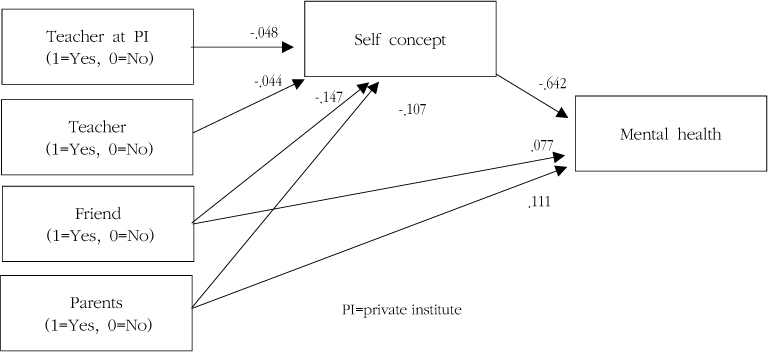
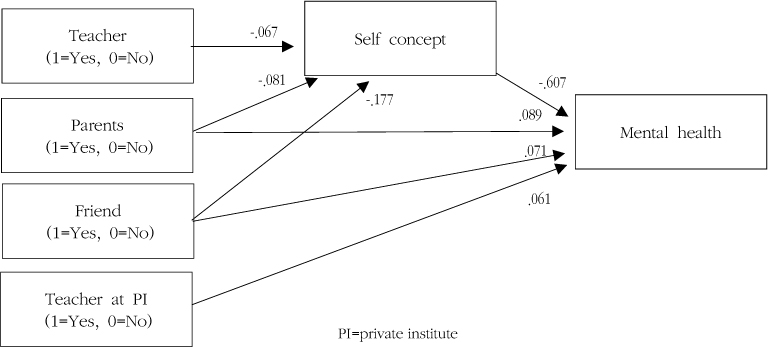
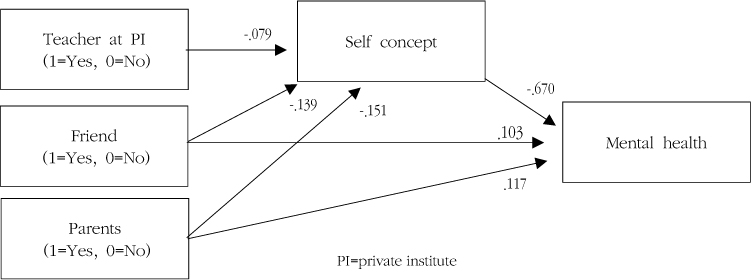
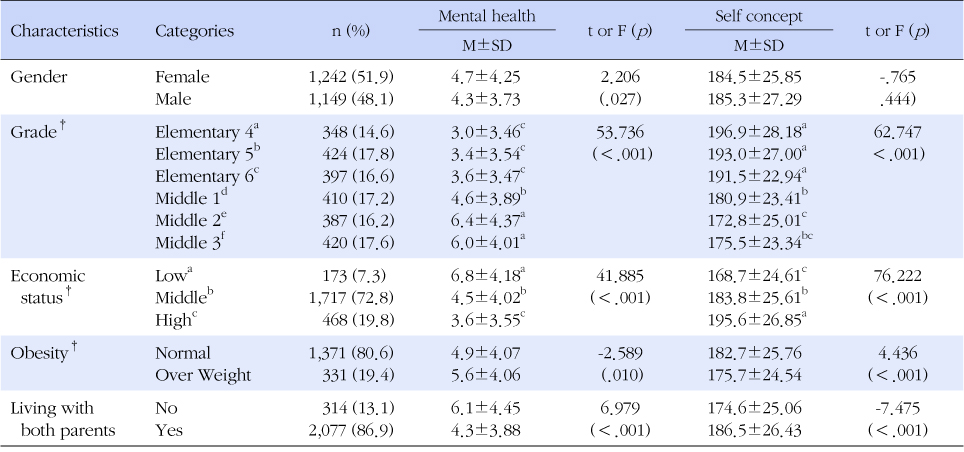
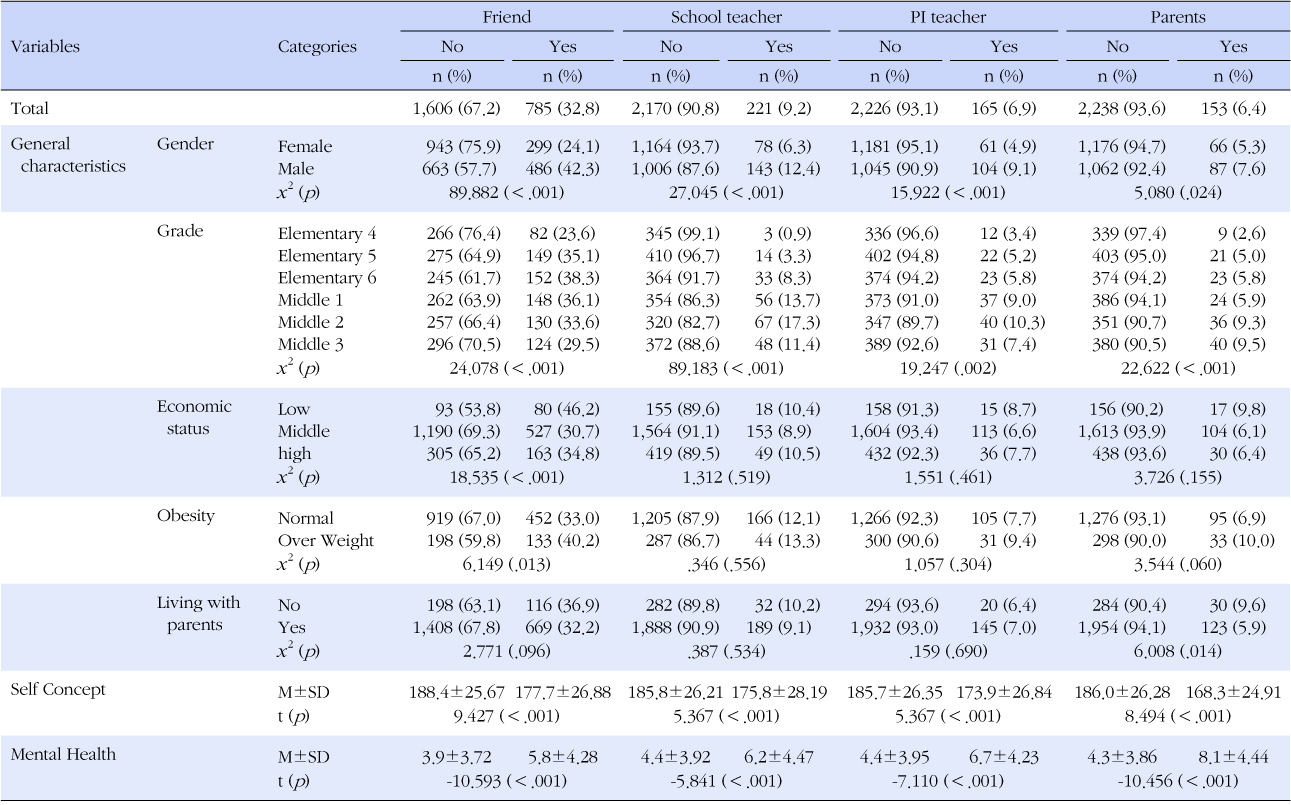

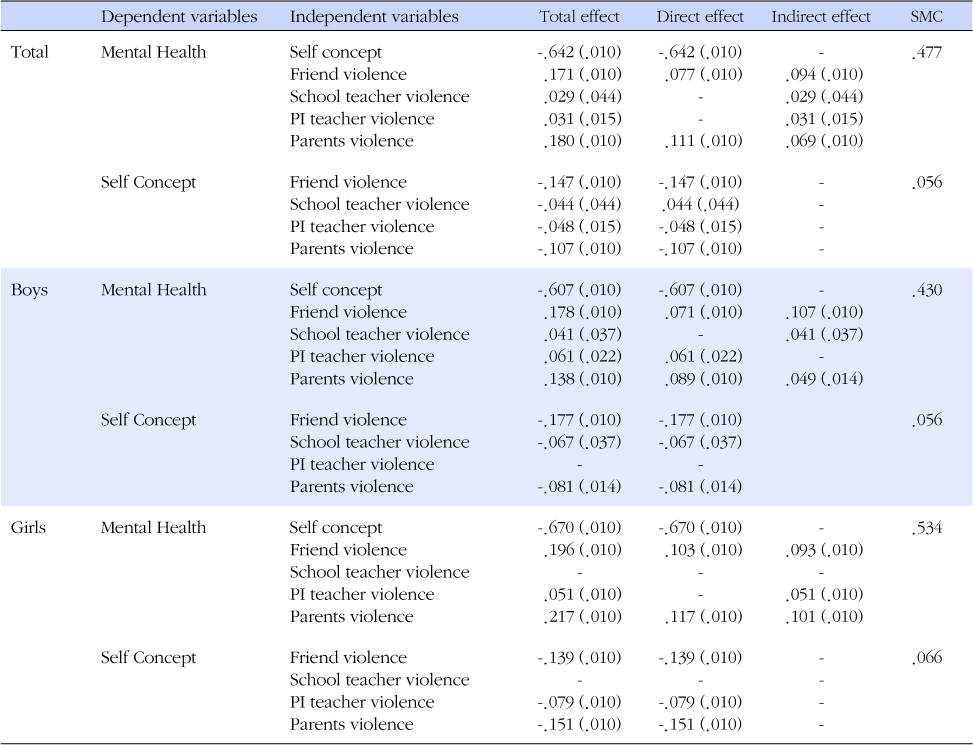
 PubReader
PubReader Cite
Cite




